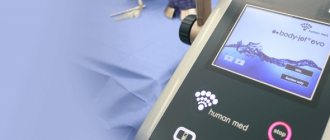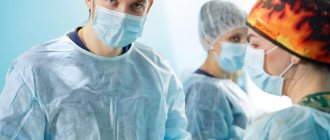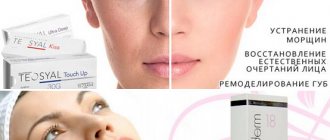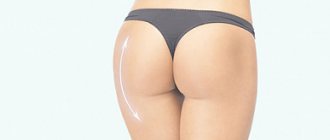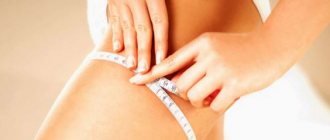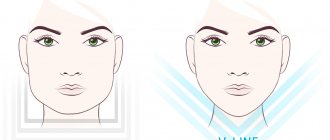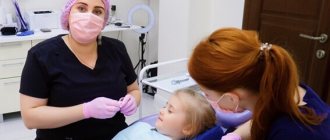Consultation with plastic surgeons with over 20 years of experience – free! Sign up by phone. Waiting for you! Beautiful women's legs have always attracted the admiring glances of men. Thin legs, or legs with an unattractive lower leg shape, can today be corrected using cruroplasty - surgery to enlarge the lower leg with a special implant.
. The risk of side effects is minimal. Today, many women, and often men, resort to correction of the shape of the lower leg. Contour plastic surgery of the lower leg (cruroplasty) helps restore the beauty and slimness of the legs in the event of any pathology or accident. However, as with any surgical intervention, to achieve the desired result, you should contact only an experienced specialist.
About the operation
The deformation of the calf muscles that increases with age is due to the anatomical and physiological features of the structure of the female body, which can be corrected by cruroplasty. Moscow offers surgery at low prices with Sergei Anatolyevich, where exceptional treatment of each patient is combined with high quality treatment and unique surgical techniques that promote rapid recovery.
Cruroplasty is a reconstructive operation aimed at endoprosthetics using implants to achieve the desired contour of the calf muscles and improve the aesthetic appearance.
According to epidemiological studies, women are several times more likely than men to seek the help of a plastic surgeon for leg correction.
Endoprosthetics of the calf muscles appeared relatively recently in the plastic surgery industry and is becoming increasingly popular due to the widespread prevalence of congenital and acquired defects of the tibia and muscle fibers in women and men. Despite the invasiveness of the operation, tibiaplasty does not require implant replacement, and the recovery period takes a short period of time.
Cruroliposuction is performed when there is excessive volume of the lower limbs, fatty formations in the intermuscular spaces and enlarged calves. Removal of the fat layer can be combined with other plastic techniques to achieve maximum effect and form a clear, elegant contour.
To correct curvature of bone structures or muscle hyperplasia, cruroplasty is performed. In Moscow, Dr. Demin’s prices are very affordable and affordable, starting from 90,000 rubles, which differs significantly in a positive direction from other aesthetic centers.
Indications and contraindications
By analogy with any surgical intervention, aesthetic cruroplasty has a number of indications when the help of a plastic surgeon is simply necessary. These include:
- excessive thinness of the legs;
- deep muscle atrophy after injury;
- obvious asymmetry of the legs;
- improper development of the calf muscles.
It is also necessary to take into account possible contraindications in which the operation may be prohibited:
- serious diseases of internal organs;
- low blood clotting rate;
- skin diseases and various external injuries;
- pathologies of the central nervous system;
- age up to 18 years.
Interesting anatomy for understanding shin surgery techniques
The ankle is formed by the fibula and tibia, surrounded by massive muscle layers that are enclosed in connective tissue fascia.
The fibers of the following muscles are involved in the formation:
- anterior tibial
- long extensor and flexor muscles of the fingers
- triceps
- posterior tibial
- popliteal
- long and short fibula.
The fibers of the tibialis anterior muscle begin from the outer crest of the tibialis anterior bone, descend down, where they connect to the ankle joint capsule in the form of a musculotendinous aponeurosis. The muscle performs supination and extension of the foot, and can be easily felt along the front surface of the ankle, in its lower part.
The contour of the calf along the back surface is formed by the triceps muscle, consisting of three bundles:
- gastrocnemius medial
- gastrocnemius lateral
- soleus.
The upper bundles of the triceps muscle form the popliteal fossa, each of the bundles is enclosed in a connective tissue sheath that provides gliding during movement. The medial parts of the muscles are layered on top of each other, forming a contour; cruroplasty of the legs is performed when there is hypoplastic deformation of the muscles or prolapse of the tendon ligaments.
The muscle fibers of the peroneus longus muscle form the lateral edge of the ankle, the curve of which gives the legs a sophisticated and sexy look. The feathery structure of the muscle explains the fan-shaped layering of the medial muscle bundles under the surrounding fascia and tendons, providing an even contour and elasticity.
Structural anomalies
From an orthopedic point of view, straight legs are considered to be the correct relationship of four points (mid-thigh, lateral calf, heel bone and knee meniscus) in a standing position, which forms a straight line without deviation.
In case of true and false curvatures, tibia plastic surgery will help hide the defect; in Moscow, cruroplasty is performed by Sergey Anatolyevich Demin, a surgeon with 27 years of experience in aesthetic medicine.
The first anomalies in the structure of the legs form in childhood, with the beginning of active walking. An arched or X-shaped develops , accompanied not only by an unaesthetic appearance, but also by pain and discomfort while walking.
An arcuate curvature is expressed in the deviation of the knees outward; the distance between the menisci significantly exceeds the norm, forming an oval. A woman’s appearance loses its aesthetics; physical exercise and training are unable to hide severe bone and joint pathology.
X-shaped curvature of the legs is accompanied by a reduction in the distance between the menisci and is a characteristic symptom of progressive rickets in childhood. As the child grows, in the absence of treatment, the altered joints and bones undergo sclerotic changes, which aggravates the pathology and irreversibly deforms the legs.
False anomalies develop with atrophic changes in muscle tissue, low body mass index and genetically determined poor differentiation of myocytes. A thin layer of muscle creates the effect of thin legs; due to the rounded knee joints, this can give the impression of a false curvature.
The most frequently asked questions about shin surgery (cruroplasty):
How strong are the implants?
Will the implants be visually noticeable?
Will the implants need to be replaced after a few years?
During shin surgery, implants are installed under the fascia of the calf muscles, which perfectly hides its presence both visually and tactilely. The presence of implants can only be determined by a specialist through targeted palpation. In the first days after surgery, some discomfort is possible, similar to a feeling of a stretched calf muscle, but this feeling is completely relieved by taking painkillers. After 3-4 weeks, the pain completely disappears, and the installed implants do not affect your lifestyle in any way.
As mentioned above, the operation of contour augmentation of the legs gives excellent aesthetic results if two rules are observed: the correct choice of implants (volume and geometry) and the most accurate determination of the level of their installation. Installation of excessively large implants can lead to a pronounced contour of the prosthesis and a clear violation of anatomical proportions. Installing implants under the muscle fascia completely eliminates the possibility of visual recognition.
Modern implants are filled with cohesive silicone gel and come with a lifetime warranty. The safety of the materials has been proven over decades of use in aesthetic medicine and there is no need to replace them over time.
Age-related changes
Cruroplasty will help prevent age-related sagging of soft tissues and stretching of tendon aponeuroses; in Moscow, Dr. Sergey Anatolyevich Demin uses innovative foreign techniques and innovative implants, combining various techniques for surgical correction of the calf muscles. Like all muscle structures of the body, the fibers of the calf muscles are subject to age-related changes and the effects of gravitational loads.
Sagging of the soft tissue occurs due to the gradual stretching of the muscular aponeurotic tendons at the points of attachment of the fibers. This leads to the “sliding” of the calf down, a complete deformation of the contour.
The effect of an obese, swollen ankle is created; physical activity can cope with such changes, however, as the physiological processes of aging increase, the problem worsens.
In addition to age-related changes, muscle ptosis develops after sudden weight loss, due to overstretching of the fascia and connective tissue sheaths by a massive layer of adipose tissue.
In this case, it is impossible to achieve elasticity and a clear contour of the ankles without surgical treatment; stretching of the skin is not amenable to training, creams or hardware cosmetology techniques. In case of severe pathology, combined plastic surgery of the lower leg is performed; prices are determined by the doctor taking into account the techniques used and the amount of correction required.
With severe excess body weight, fatty involution of muscle tissue occurs with an increase in the volume of the ankles, adipocytes imbibe the intermuscular space with massive growth of connective tissue bridges.
Shin surgery is performed to restore shape, remove excess fat and create a clear, graceful contour. A large volume of ankles provokes varicose veins due to dysfunction of the valves of the contact veins; timely implementation of cruroliposuction prevents the development of the disease.
Indications for leg plastic surgery
Even a severe degree of arched or X-shaped deformity can be corrected by combined cruroplasty. The price in Moscow from Dr. Demin starts from only 90,000 rubles, combined with a purely individual approach to each patient, full medical support at all stages of calf muscle plastic surgery.
The main indications for plastic surgery include:
- true curvature (arch- and X-shaped pathology of bones and joints)
- hypoplasia, muscle fiber atrophy
- asymmetrical calf position
- congenital hypoplasia of the medial part of the gastrocnemius band
- volume reduction
- increase in volume
- loss of contour
- ptosis of soft tissues with the formation of skin folds
- post-traumatic atrophy
- recovery after unsuccessful operations.
If the volume of plastic surgery of the shins is insufficient, it is performed to fill the facial spaces, this improves the appearance, gives it aesthetics, and has a positive effect on blood circulation. Severe atrophy of muscle fibers leads to sclerosis of the sheaths and fascia, which provokes the collapse of arterial and venous vessels.
Compensation for the missing volume with an endoprosthesis promotes instant straightening of the arteries and veins and restoration of blood circulation in the distal parts of the legs. The muscles become toned and elastic, which explains the increase in cosmetic effect in the postoperative period.
The increased volume of the ankles is eliminated by mono-liposuction, which has a beneficial effect on the condition of the microvasculature and lymphatic ducts. The fat layer surrounds microcapillaries, provokes oxygen starvation of tissues and the development of chronic pathology. Classic plastic surgery of the legs consists of a combination of cruroliposuction and endoprosthetics.
Atrophy after injury in a large percentage of cases is combined with severe asymmetry and deformation of the calves; leg cruroplasty is required to restore shape, contour and symmetry. Plastic surgery of the calf muscles allows a woman to become sexy and self-confident, without embarrassment to wear high heels and dresses above the knee.
Indications for lipofilling of the legs
Lipofilling of the legs is a procedure that is used by both men and women who want to improve the appearance of their legs. In case of true curvature, which is based on bone deformation, physical activity and sports will not help hide the curvature, and in the case of false curvature with poor development of the calf muscles, this is possible, but the task requires long-term training.
The most common reason why patients turn to a surgeon is subjective dissatisfaction with the shape/volume of the legs and the desire to make their appearance more aesthetic. Other indications include:
- lack of volume in the calf and calf areas, excessive thinness of the legs;
- acquired/congenital atrophy of muscle tissue;
- leg asymmetry;
- consequences of injuries.
Dr. Amjad Al-Yousef undergoing lipofilling of the lower leg
How lipofilling of the lower leg is performed in the photo
Lipofilling of the lower leg in progress
Contraindications
Leg surgery is performed under endotracheal anesthesia or spinal anesthesia to achieve optimal relaxation of deep muscle structures.
The operation has absolute contraindications, which include:
- failure of internal organs and systems
- pathology of the heart, blood vessels
- autoimmune pathology
- immunodeficiencies
- neoplasms with metastasis
- sugar metabolism disorders, hyperinsulinemia
- diseases of the hematopoietic organs
- amyotrophy, myasthenia gravis
- hemophilia.
Relative contraindications are:
- bacterial and mycotic infection
- lactation period
- exacerbation of ENT pathology and pathology of the hepatocellular system
- leg injuries.
In case of chronic diseases, plastic surgery of the legs is performed only after achieving stable remission to prevent the development of postoperative complications. If a cruroplasty operation is prescribed before the symptoms of exacerbation of a chronic pathology appear, the date of the plastic surgery is postponed until the patient has fully recovered.
Frequent exacerbations of inflammation of the knee joints with true curvatures are a relative contraindication and require massive anti-inflammatory therapy and supervision by the attending physician. The period of postoperative recovery after cruroplasty depends on the condition of the joints, microvasculature and lymphatic vessels.
Preparation for surgery:
The operation is performed under general anesthesia, so before it you need to do an ECG along with basic preoperative tests. At your initial appointment with a plastic surgeon, you can discuss the shape you would like to achieve. Calf implants come in smooth and textured, symmetrical or anatomical. The choice depends on the task at hand and the initial data. Quite often they use prostheses of different sizes, because one leg is always a little larger. Special preparation for the operation is not required, but if there is venous pathology, then it is better to first discuss the possibility of cruroplasty with the treating phlebologist. This can be done in one visit to our clinic. On the day of the operation you must arrive on an empty stomach.
Cruroplasty: preparation
Before setting the date for the operation, the woman undergoes a full comprehensive examination with laboratory tests, consultations with doctors and instrumental studies. Consultation with doctors allows you to diagnose exacerbations of concomitant pathology, which can negatively affect the recovery process after cruroplasty.
In the presence of congenital anomalies in the structure of bone structures and joints, consultation with an orthopedist and neurologist is indicated. The doctor examines the calf muscles, knee and ankle joints, determines the degree of sclerotic changes and excludes the presence of exacerbations of arthritis and arthrosis.
Laboratory tests are aimed at identifying acute or chronic inflammation, pathology of hemostasis with increased bleeding, and thrombus formation disorders. Instrumental examination methods include ultrasound examination of muscle fibers if the patient has suffered injuries or myodystrophic diseases.
Doppler examination of blood vessels allows the patient to identify chronic venous pathology, varicose veins, thrombophlebitis or atherosclerotic changes. Doppler is performed a week before surgery and a week after it to eliminate the risk of thrombus formation in large venous trunks and pathology of the valve apparatus.
Before surgery, the patient limits the consumption of alcoholic beverages and smoking, which negatively affect the recovery process, worsening the overall prognosis. Doctors recommend excluding sweet and starchy foods from food several weeks before surgery to reduce the likelihood of mycotic or bacterial flora.
After a complete examination, and in the absence of contraindications, the patient undergoes cruroplasty; the cost is determined by the techniques used and the implants chosen.
During the consultation before the operation, the surgeon creates, if necessary, a three-dimensional image of the desired result, taking into account the wishes of each patient, using a computer. The height of the bend, the severity of the contour and side ridges are determined.
Preparation for lipofilling of legs
The surgeon evaluates the anatomical features, the structure of the skeletal and muscular systems, and the distribution of subcutaneous fat. Using volumetric modeling technology, he marks donor areas for transplantation and areas for introducing biomaterial.
Next, the patient is sent for examination to exclude contraindications. It is necessary to pass a general urine and blood test, determine the blood group and Rh factor, do a coagulogram, a sugar test, ECG and fluorography, undergo a laboratory examination for hepatitis B, C, HIV, syphilis. You will also need a conclusion from a therapist or phlebologist.
Types of cruroplasty
To restore a clear contour, elastic and graceful calves, cruroplasty of the legs is performed; before and after photos of the clinic’s patients demonstrate an instant transformation of the legs.
In order to increase the volume, operations are performed:
- endoprosthetics
- lipofilling.
Volume reduction is performed using liposuction methods:
- classical
- tumescent
During reconstructive combined operations in patients after intensive weight loss, additional cruropexy is required, which consists of tightly suturing stretched muscle-aponeurotic fibers to the site of fixation. This technique eliminates the recurrence of soft tissue ptosis as age-related changes increase, and gives the surgeon the opportunity to give the legs the desired shape.
Cruroplasty
So, the first thing you need to do is undergo the necessary examinations and tests. This is done to ensure that there are no contraindications for the operation. The result of the operation, the period of rehabilitation and your feelings after the operation depend on your state of health.
Some groups of drugs affect blood clotting, reducing it. These include non-steroidal anti-inflammatory drugs - acetylsalicylic acid, paracetamol, ibuprofen, diclofenac. If for some reason the patient takes them, then this should be discussed with the doctor and stop using them at least 2 weeks before the operation.
The operation is not performed if you are sick with the flu, ARVI or other ailments. The operation will also have to be rescheduled in case of exacerbation of any chronic diseases.
Any plastic surgery is planned taking into account your menstrual cycle and is not performed on your period.
Drinking alcohol and smoking before surgery are not advisable; also warn your doctor if you are taking medications.
Tell your doctor if you have ever had any allergic reactions .
Your doctor and anesthesiologist will need to know if you have any sudden bleeding (nose, uterine, etc.).
It is necessary to stop visiting the gym three days before surgery and develop a diet with minimal salt content. This substance causes swelling
In addition to physical health, your emotional state is important: it is better not to have surgery during periods of any stress at work or at home.
In the morning, it is better to try to wake up in a good mood and try not to be afraid of the upcoming operation, to tune in to a positive outcome.
Preparation for cruroplasty is very important, so take all the recommendations of your plastic surgeon seriously, because both the result of the operation and the postoperative period depend on it.
All this will help your body more easily endure both the operation and its consequences.
List of necessary tests for surgery under general anesthesia (anesthesia)
- Clinical blood test
- platelets
- coagulability
- coagulogram
- General urine analysis
- Microreaction (RW)
- Form No. 50 (HIV)
- Blood chemistry:
- sugar
- prothrombin
- bilirubin
- urea
- AST
- ALT
- Blood type
- HBs Ag Australian antigen (hepatitis B)
- anti-HCV (antibodies to hepatitis C)
- ECG
- Fluorography
- Therapist's conclusion on the possibility of performing the operation
NOTE:
- tests are taken in the morning on an empty stomach;
- blood tests for AIDS, syphilis and hepatitis are valid for 30 days;
- clinical blood test is valid for 14 days;
- urine test is valid for 14 days;
- biochemical tests are valid for 14 days;
- ECG is valid for 30 days;
- FLG is valid for 6 months.
Endoprosthetics: types of implants
For thin, emaciated calves and protruding knee joints that distort the contours of the legs, augmentation cruroplasty of the legs is performed, the price of which depends on the type of implants used and their manufacturers.
The classic method of shin surgery is performed with full-shell semilunar-shaped silicone implants.
The doctor uses only high-quality implants from European and Israeli manufacturers in the clinic, which have undergone numerous clinical studies. The proven safety and durability of implants is due to a durable capsule that is not susceptible to traumatic factors.
Implants for calf muscle sheaths are developed taking into account the anatomical features of the area and have special stop ligatures that prevent the endoprosthesis from sliding along the connective tissue fascia.
The implants are filled with a sterile saline solution or a cohesive gel, which allows the patient to change the shape of the endoprosthesis when the calf muscle bundles contract during walking.
Augmentation surgery of the lower leg requires the use of implants with a textured surface for strong fixation and to prevent the effect of “sliding” in the patient.
Implants are classified according to their shape:
- semilunar classic for symmetrical plastic surgery
- anatomical with the maximum volume of the upper third to compensate for post-traumatic atrophy.
Implants with a textured surface fuse with surrounding tissues faster, which significantly reduces the risk of rejection. Clinical studies have proven the minimum percentage of repeated reconstructive surgeries among patients after endoprosthetics due to the rapid growth of granulation tissue and rigid fixation of the implant.
Indications for lower leg replacement include:
- Restoration of muscles in the presence of atrophy, manifested as a consequence of various diseases;
- Congenital inexpressiveness of the muscle tissue of the lower leg;
- Surgical rehabilitation of legs after accidents and serious injuries;
- True and false curvature of the legs.
To replenish the contours and increase the volume of the legs, specially designed implants are used; they are selected during an individual consultation in accordance with the anatomical features and wishes of the patient. Modern implants for shin augmentation are available in various volumes and geometries, with a textured or smooth surface (shell).
The operation is also performed for curvature of the legs. There is a distinction between true and false curvature. True curvature of the legs is congenital
a feature of the anatomy of the lower extremities, which is associated with deformation of the tibia. Externally, the defect manifests itself from the perineum to the closed ankles along the outer contour (O-shaped curvature) or the impossibility of closing the ankles with the thighs closed in a free position (X-shaped curvature).
False curvature of the legs
- this is a structural feature of the lower extremities in which there is no bone deformation. This type of curvature is associated with the distribution of soft tissues in the lower leg area. Contour plastic surgery is successfully used to correct shins with false and moderately expressed O-shaped curvature of the shins. In the postoperative period, a mandatory condition is to limit physical activity for an average of a month. You should also wear compression garments for a month after surgery.
Endoprosthetics: technique
Patients who decide to undergo surgery for the first time to restore an aesthetic appearance ask the question of how much cruroplasty costs. Low prices in the clinic of Sergei Anatolyevich - from 90,000 thousand rubles, patient reviews can be viewed in the corresponding section of the site.
Leg surgery is performed under general endotracheal anesthesia with additional epidural anesthesia for the patient. This allows you to achieve complete relaxation of deep muscle fibers and prevent displacement of the implant in the postoperative period. Before the operation begins, the doctor places a marker on the area where the implant will be installed to ensure symmetry.
Endoprosthetics is a unique operation that instantly restores the contour and shape of the calf area. Plastic surgery of the lower leg using endoprostheses is performed using several approaches:
- submuscular
- subfascial.
Subfascial method
The incision is made in the physiological skin fold under the knee, using a blunt bougienage method to create an artificial pocket under the connective tissue membrane of the superficial calf muscle bundles. A small silicone implant is carefully inserted into the pocket, which is additionally fixed with stop ligatures in the upper part of the popliteal aponeurosis.
Submuscular method
Designed specifically for the use of semilunar full-shell implants that require strong fixation. Soft tissues, ligaments and tendons tightly surround the endoprosthesis, preventing its movement. The incision is made in the popliteal region of a larger size than with subfascial endoprosthetics.
A pocket is formed under the deep fibers of the calf muscles, where the endoprosthesis is installed. The tension of the muscle plates leads to a strong retention of the endoprosthesis and eliminates the possibility of displacement.
If there is insufficient tension in the muscle fibers, cruropexy is performed by resection and tightly suturing connective tissue bundles, which are rigidly attached at the sites of anatomical attachment and to the popliteal aponeurotic cord.
The submuscular method is used more often due to the creation of the required shape without the risk of excessive contouring of the implant. Modern endoprostheses for cruroplasty of the latest generations interact with surrounding tissues, succumbing to the resistance of muscle fibers, and take on a physiological shape during active movements. The results of cruroplasty after submuscular fixation are distinguished by their naturalness and instant transformation of the contour of the legs and the shape of the calf muscles.
When the surgeon installs implants on both legs, he compares the position and strength of fixation of the endoprosthesis. Then the fascia, tendons, aponeuroses and muscle fibers are sutured layer by layer. The epidermis is sutured with a cosmetic transcutaneous suture, which heals with minimal cosmetic defects not visible to the naked eye.
Why go to the N.I. Pirogov Clinic for the best results?
- The Pirogov Clinic was recognized as the best plastic surgery clinic according
to the national rating of private clinics in St. Petersburg by the medical portal “Doctor Peter” and the city portal “Fontanka.ru” in 2021; - qualified plastic surgeons with extensive experience in aesthetic surgeries;
- our doctors constantly exchange experience with foreign specialists, attract colleagues from Israel, which allows us to perform plastic surgeries using progressive world techniques;
- the opportunity to undergo all preoperative examinations in the clinic within one day;
- own laboratory: test results - quickly and with a guarantee of reliability;
- equipping operating rooms with the most advanced medical equipment from leading Western companies;
- attentive and responsible medical staff: a team of anesthesiologists, resuscitators, assistants and nurses coordinately and quickly resolves any issues around the clock;
- the highest standards of equipment sterility and patient safety, meeting the requirements of regulatory authorities;
- use of the latest generation of anesthesia that does not cause any discomfort after the intervention;
- modern comfortable hospital: you feel like you are in a European hotel room;
- quick return to normal life: as a rule, patients are discharged the very next day after the intervention;
- the ability to perform several operations simultaneously, which means you get the best result in one intervention;
- interest-free installment payment for plastic surgery.
Make an appointment
Lipofilling
When the contour of the ankles is deformed due to excess fatty tissue, cruroplasty is performed to create an aesthetic shape; before and after photos demonstrate the stunning transformation of the legs. A woman gets sporty, graceful ankles, the shape of which does not need to be maintained by constant exhausting training.
Plastic surgery of the legs using lipofilling involves autotransplantation of fat granules from under the lower bundles of the gastrocnemius fascia into the connective tissue pockets in the area of the head of the triceps muscle. Fat granules are removed using special small-diameter cannulas, which do not leave marks and do not require additional suturing of puncture sites.
The collected fat is purified by centrifugation directly during the operation, after which it is injected into the patient's fascial pockets of the upper part of the calf muscles.
Shin plastic surgery is performed by filling the intermuscular spaces with fat granules, removing excess tissue and replenishing the missing volume with fat or additional installation of an implant (if there is a significant tissue deficiency).
Lipofilling can be performed under local infiltration anesthesia, is atraumatic and tissue-saving, but the effect lasts much shorter than with endoprosthetics. Artificial endoprostheses cannot be absorbed, fit tightly at the site of initial installation, and are not susceptible to sclerotic changes.
For thin, emaciated ankles, fat is taken from the gluteal area or sides, after which autotransplantation cruroplasty is performed; patient reviews note a short rehabilitation period, rapid tissue restoration and the woman’s natural appearance. The choice of cruroplasty method depends on the desired results, indications for surgery and the degree of increase in calf volume.
How is the operation performed?
Cruroplasty is not a complicated operation and takes about 30 minutes. The most important part of the operation is the formation of a bed under the muscle fascia. At this stage, the surgeon must decide what size implant to install. Sometimes it happens that the implant that was planned to be installed is too large and the volume of the bed under the fascia cannot be expanded to the required size at one time. Then it is recommended to place a smaller implant first. After 3-4 months, when the tissues of the lower leg adapt and stretch, you can perform a second operation and install a larger implant.
Liposuction
In case of increased volume of the ankles, unaesthetic appearance and loss of shape, reconstructive plastic surgery of the legs is performed; after the operation, the legs acquire a clear, even contour, become thin and even. At the clinic, doctors use several methods of cruroliposuction aimed at reducing volume and restoring attractiveness.
Plastic surgery of the legs is rarely performed using classical liposuction due to the atypical location of fat accumulations, in contrast to the gluteal area. Removal of adipose tissue is performed only from deep facial spaces, which reduces the risk of postoperative complications and violations of the aesthetic appearance.
When removing a significant amount of fat from an overweight patient, cruropexy to tighten the devastated facial pockets. Pexy is performed with minimal trauma; the incision is made in the popliteal area, followed by a tight lift.
How is lipofilling of the legs performed?
The lipofilling procedure involves several successive stages. The operation begins with antiseptic treatment, application of special markings and administration of anesthesia. At the first stage of the procedure, Weiser liposuction of excess adipose tissue from the donor area (for example, from the abdomen, waist, hips, etc.) is performed. To do this, the surgeon makes micropunctures at pre-designated points and uses a thin cannula needle to remove excess adipose tissue. At the second stage, the resulting adipose tissue undergoes special processing in a centrifuge, which results in a fatty autograft prepared for transplantation, cleared of damaged fat cells and blood impurities. At the third stage, the required amount of the obtained material is injected into the lower leg area using a cannula. At the end of the procedure, the puncture sites are treated with an antiseptic, and a tight sterile bandage is applied to the intervention areas.
Combined plastic surgery of the legs
In case of arched and X-shaped true curvature of the legs , a combined plastic surgery of the lower leg is performed; before and after photos reflect the restoration of orthopedic lines with visual straightening of the patient’s lower extremities. Combined plastic surgery of the legs begins with the installation of full-shell semilunar implants in the submuscular spaces with rigid fixation.
Then, depending on the type of curvature, fat tissue is taken from the medial or lateral side of the ankle from deep intermuscular pockets using lipofilling. Fat granules are injected after centrifugation over the installed implant to create additional volume.
This guarantees a natural appearance and allows you to maintain the aesthetics of your legs for a long time. In case of an X-shaped curvature, the implant is placed closer to the lateral edge, and fat granules are injected into the upper part of the calf muscle. In this case, adipose tissue is taken from the inner surface of the legs, closer to the popliteal region.
In case of arched curvature of the ankles, bones and joints, plastic surgery of the legs is carried out with the installation of implants on the medial surface, liposuction from the outside to create a three-dimensional effect. Fat granules are injected under the superficial fascia directly above the implant to create additional volume and smooth the contour.
Plastic surgery of the lower leg is completed by layer-by-layer suturing of the surgical wound after installation of the implant. Rehabilitation after cruroplasty depends on the techniques used and the size of the implants.
After the operation, the patient is put on a compression bandage (underwear), which prevents the formation of hematomas and damage to soft tissues.
The tightening clamp should be worn throughout the postoperative period to adapt the muscle and tendon fibers after endoprosthetics to the increased load. The compression effect stimulates normal blood circulation, promotes capillary restoration and reduces the risk of postoperative thrombus formation.
How to choose an implant?
A correctly selected and installed calf muscle prosthesis should be invisible visually and to the touch. Its size and shape are selected by a plastic surgeon, who takes into account the wishes of the patient and the structural features of his legs. The most commonly used calf muscle prosthesis is POLYTECH®. They are presented in 2 profiles and 9 sizes:
- Symmetrical profile (6 sizes);
- Anatomical profile (3 sizes).
It is this wide range that allows you to individually select implants and carry out the ideal calf augmentation with implants for men and women. POLYTECH® calf implants are filled with cohesive silicone gel with a dense consistency that meets all the requirements for implants of this type.
Rehabilitation
To restore severe curvatures of the legs and improve the appearance, cruroplasty of the legs is performed; patient reviews note fairly rapid tissue repair after surgery, the absence of complications and the inconspicuousness of the sutures. The recovery period lasts up to two months; the patient spends the first days in the clinic to fully control his condition.
After the operation is completed, the patient is transferred to a separate room, where he rests after anesthesia. Trained staff treats post-operative wounds, the doctor monitors the position of the implants and the course of the rehabilitation period. A course of non-steroidal anti-inflammatory and antibiotic drugs is prescribed to prevent the addition of secondary bacterial flora.
Hygienic procedures are recommended to begin after the sixth day of the rehabilitation period, when the transcutaneous sutures have undergone primary repair. On the 11th day, the doctor removes the stitches and applies an aseptic bandage with medication to accelerate the growth of granulation tissue. The swelling of the calf muscle area gradually subsides over three weeks, then the doctor removes the protective plates.
After removing the compression clamps, there may be a feeling of fullness after endoprosthetics, which is associated with the “shrinkage” of the implant and the muscles getting used to it. At this time, the patient reduces physical activity and wears shoes with stable heels of 4-5 cm for optimal stretching of muscle fibers.
Doctors recommend avoiding visiting public places and exposure to heat for at least three months after shin surgery has been performed. Reviews after the operation note the rapid elimination of pain and a general improvement in the recovery process, subject to the doctor’s recommendations.
Why should you contact the UMG Center for Aesthetic Medicine for cruroplasty?
Specialization
Contouring of the legs is one of the important areas of the UMG Center for Aesthetic Medicine. Over the past year, the center has performed about 30 successful cruroplasty operations.
Equipment
The equipment of the UMG center corresponds to the level of the best European clinics. Each operating room is tested by the stars of world surgery during master classes conducted by the UMG center. All operations are performed using gentle, low-traumatic methods.
Safety and comfort
The UMG center employs anesthesiologists and resuscitators of the highest level; two key doctors have ten years of experience in operating rooms. A resuscitation team is on duty at the center 24 hours a day. After the operation, you will be in an individual comfortable room under the supervision of a doctor and nurse.
Cruroplasty is a safe and effective operation, after which you will get an ideal result. It is low-traumatic; during its implementation, nerve endings and blood vessels are not affected. After such a surgical procedure, the rehabilitation period is as easy as possible. Thanks to contouring, your legs will be toned and symmetrical, you will not be able to hide them under long and voluminous clothes. The shape and size of your shins will be perfect!
